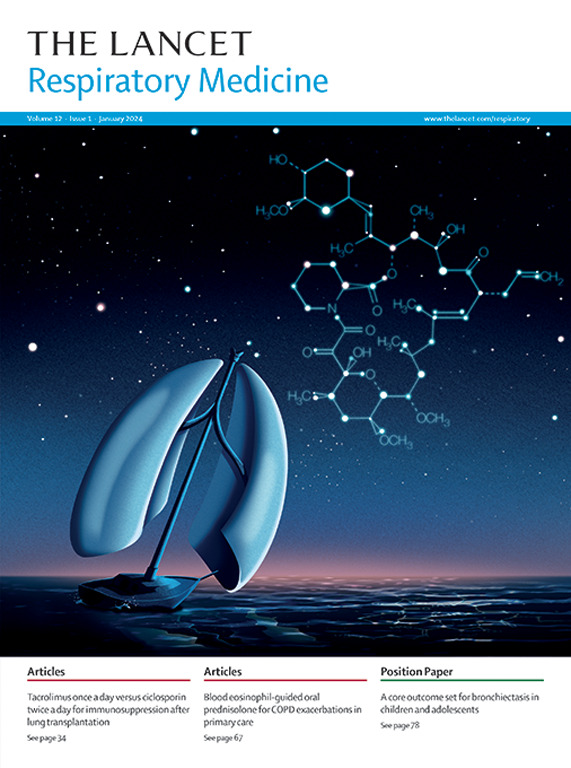Sweat chloride and lung function responses to elexacaftor–tezacaftor–ivacaftor in people with cystic fibrosis with two versus one responsive CFTR variants: an analysis of two real-world observational studies
IF 32.8
1区 医学
Q1 CRITICAL CARE MEDICINE
引用次数: 0
Abstract
Background
Among people with cystic fibrosis, sweat chloride and lung function response to elexacaftor–tezacaftor–ivacaftor (ETI) is variable. We hypothesised that the presence of two versus one ETI-responsive CFTR variant could predict response variability.Methods
In this analysis of two real-world observational studies, data from a French national cohort of adults (aged ≥18 years) with cystic fibrosis and at least one F508del variant treated with ETI and the French compassionate programme for ETI in people (aged ≥6 years) with cystic fibrosis without F508del were used to examine sweat chloride concentrations (SCCs) after ETI initiation, and the absolute change in SCC and percentage of predicted forced expiratory volume in 1 s (ppFEV1) following ETI initiation. The ETI responsiveness of CFTR variants was determined following the French compassionate programme's classification.Findings
Among 1266 participants, 834 had two ETI-responsive variants and 432 had only one. Median SCC after ETI initiation was 36 mmol/L (IQR 24–50) in participants with two ETI-responsive variants and 53 mmol/L (26–72) in those with only one (p<0·0001). The proportion of participants with SCC of less than 30 mmol/L was 298 (36%) of 834 among those with two ETI-responsive variants and 65 (15%) of 432 in those with one ETI-responsive variant (χ2 p<0·00001). Multivariable analyses showed that the number of ETI-responsive variants was a determinant of SCC after ETI initiation (p<0·0001) but not of the absolute change in ppFEV1 (p=0·80).Interpretation
People with cystic fibrosis with two responsive CFTR variants had a better correction of CFTR function in sweat glands after ETI initiation than those with only one responsive variant, but the response in terms of ppFEV1 was similar. These findings suggest that maximal improvement in lung function could be reached with current CFTR modulators and that no further increase in lung function would be expected from more potent restoration of CFTR function. Reaching normal lung function in people with cystic fibrosis and established lung disease might be limited by irreversible lung damage, suggesting that new therapeutic strategies aimed at improving lung function should be developed.Funding
Association Vaincre la Mucoviscidose, Société Française de la Mucoviscidose, and Filière Maladies Rares MUCO-CFTR.囊性纤维化患者两种与一种应答性CFTR变异体的汗氯化物和肺功能反应:两项现实世界观察性研究的分析
在囊性纤维化患者中,汗氯化物和肺功能对elexaftor - tezactor - ivacaftor (ETI)的反应是可变的。我们假设,两种与一种对eti有反应的CFTR变体的存在可以预测反应变异性。方法:本研究分析了两项真实世界的观察性研究,数据来自法国国家队列(≥18岁)囊性纤维化患者和至少一种F508del变体接受ETI治疗的成年人,以及法国无F508del的囊性纤维化患者(≥6岁)ETI同情计划,用于检测ETI启动后的汗液氯化物浓度(SCCs)。ETI启动后SCC的绝对变化和1 s内预测用力呼气量百分比(ppFEV1)。CFTR变体的ETI响应性根据法国同情计划的分类确定。在1266名参与者中,834人有两种e - e反应变异,432人只有一种。在有两种ETI应答变异的参与者中,ETI启动后的SCC中位数为36 mmol/L (IQR 24-50),而只有一种ETI应答变异的参与者中,SCC中位数为53 mmol/L (26-72) (p< 0.0001)。两种戊二酸酯反应变异中SCC小于30 mmol/L的比例为834人中298人(36%),一种戊二酸酯反应变异中65人(15%)(χ2 p< 0.00001)。多变量分析显示,ETI应答变异的数量是ETI启动后SCC的决定因素(p= 0.0001),但不是ppFEV1的绝对变化(p= 0.80)。具有两种应答性CFTR变异的囊性纤维化患者在ETI启动后比只有一种应答性变异的患者在汗腺中具有更好的CFTR功能纠正,但在ppFEV1方面的应答是相似的。这些发现表明,使用目前的CFTR调节剂可以达到肺功能的最大改善,并且更有效地恢复CFTR功能不会进一步增加肺功能。囊性纤维化和肺部疾病患者达到正常肺功能可能受到不可逆肺损伤的限制,这表明应该开发旨在改善肺功能的新治疗策略。法国黏液变性医学会、法国黏液变性变性医学会和菲律宾罕见疾病协会资助。
本文章由计算机程序翻译,如有差异,请以英文原文为准。
求助全文
约1分钟内获得全文
求助全文
来源期刊

Lancet Respiratory Medicine
RESPIRATORY SYSTEM-RESPIRATORY SYSTEM
CiteScore
87.10
自引率
0.70%
发文量
572
期刊介绍:
The Lancet Respiratory Medicine is a renowned journal specializing in respiratory medicine and critical care. Our publication features original research that aims to advocate for change or shed light on clinical practices in the field. Additionally, we provide informative reviews on various topics related to respiratory medicine and critical care, ensuring a comprehensive coverage of the subject.
The journal covers a wide range of topics including but not limited to asthma, acute respiratory distress syndrome (ARDS), chronic obstructive pulmonary disease (COPD), tobacco control, intensive care medicine, lung cancer, cystic fibrosis, pneumonia, sarcoidosis, sepsis, mesothelioma, sleep medicine, thoracic and reconstructive surgery, tuberculosis, palliative medicine, influenza, pulmonary hypertension, pulmonary vascular disease, and respiratory infections. By encompassing such a broad spectrum of subjects, we strive to address the diverse needs and interests of our readership.
 求助内容:
求助内容: 应助结果提醒方式:
应助结果提醒方式:


